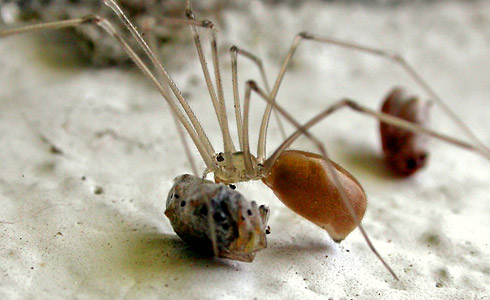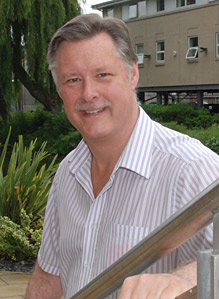Eight-legged allies
Mon, 09 Jul 2012 12:06:00 BST
University experts discover how spiders aid the fight against woodworm – and maybe malaria too

The Pholcus Phalangioides spider (Photo courtesy of Olaf Leillinger)
PROPERTY owners who need to banish destructive woodworm could have an eight-legged alternative to chemical sprays that are potentially dangerous and only partially effective. They could enlist the aid of very special spiders that will seek and devour the destructive grubs. And a further, exciting possibility is that one of the world’s deadliest diseases could be curtailed by the creatures.
Research by sustainable architecture experts at the University of Huddersfield is showing that a spider named Pholcus phalangioides – sometimes known as the cellar spider – is very effective at killing off woodworm in old buildings and now there are plans to devise special nesting boxes for the creatures.

But the Pholcus – which actively hunts its prey instead of simply lurking in a web – could be an even bigger boon. Lecturer Charles Hippisley-Cox (pictured), who is pioneering the research, has noticed that these spiders will also eat mosquitoes.
“This could have global significance, because if we can tackle mosquito populations with this spider and design something that will house these spiders in appropriate places, we could reduce the threat of malaria. This is probably the most exciting aspect of the project,” he says.
But it was the work done on the restoration of old buildings by Mr Hippisley-Cox and his colleagues in a sustainable architecture research group at the University of Huddersfield which revealed the potential of the wispy-legged, but voracious Pholcus phalangioides.
Mr Hippisley-Cox, a historic buildings specialist, has lectured at the University since 1996. He and his colleagues have been experimenting with restoration techniques in a part of France where derelict old buildings are plentiful and relatively inexpensive. It is mandatory in France to use chemicals to treat woodworm. But not only were the sprays a potential health hazard, but it was impossible to achieve 100 per cent effectiveness.
“After spraying, the building seemed to be lifeless,” said Mr Hippisley-Cox. “But ironically, significant numbers of woodworm had survived, presumably in areas that had escaped the spray, and so had some Pholcus. This predatory spider would feed on the woodworm beetles as they emerged from the timbers.”
First encounters
He had first encountered and observed the behaviour of the Pholcus while living in the south of England. He noted how it tackled and defeated a much larger species of spider.
“Pholcus don’t trap prey in their webs like some – they go off hunting. They nest in webs, but when they are hungry they will go off in search of food. Rather like Spiderman in the movies, the Pholcus flicks silk at its prey which goes into a panic and then the Pholcus moves in and will bite it. Fortunately its teeth and its jaws are not sufficiently large to be able to bite humans!”
When it was realised that the Pholcus had the potential to eliminate woodworm without the use of chemical treatment, Mr Hippisley-Cox and his team continued to observe the creatures and gather data.
They discovered that the spider population was self-regulating.
“If there is a lot of food around, the population will grow and become huge. When the food source starts to dwindle the spiders will start eating each other and stop breeding altogether, so it goes back down to just a couple of pairs in a room again. If infestation comes back, they will start to grow.”
But what if householders are not attracted by the idea of sharing living space with spiders?
“The thing I would say in favour of this type of spider is that it is slow-moving and rather graceful and lovely to look at. It doesn’t feel threatening in any way, even if you are an arachnophobe. The Pholcus doesn’t bite humans and doesn’t generate any mess. Its webs are never dirty. It will leave a dusty web and make a new one.”
The next phase of research will seek ways of developing populations of Pholcus phalangioides. For this, an entomologist could be recruited. Also, a product designer could be brought on board to work on a nesting box for the spiders. And if the potential for the Pholcus to devour malaria-inducing mosquitoes is to be realised, a medical professional could be enlisted too.
At the University of Huddersfield, Charles Hippisley-Cox is course leader for BSc Architectural Technology, which places emphasis on the refurbishment of old buildings and building pathology. This has led to many graduates specialising in building conservation.







